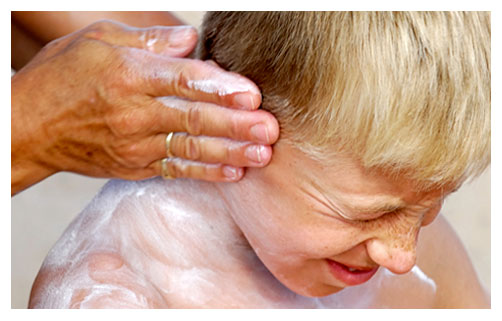



And remember: Wearing protective clothing, such as hats with brims, sunglasses, and long sleeves and pants or skirts, can also help prevent sunburn.
What to know about sunscreens and sunblocks:
Differences between chemical and physical sunscreens
Chemical sunscreens are by far the most popular. By absorbing harmful ultraviolet (UV) radiation, they prevent burning—when used correctly—and can permit tanning. Apply a chemical sunscreen 30 minutes before sun exposure to give it enough time to penetrate the skin.
Physical sunscreens, or sunblocks, shield the skin from the sun. They prevent sunburn by reflecting more than 99% of harmful rays (as well as the rays that cause the skin to tan). Sunblocks can be applied just before exposure. They are becoming increasingly popular. Until recently, only messy creams like zinc oxide were available. But now there are "micronized" substances that are virtually invisible once applied to the skin.
There is some debate over whether the chemicals used in sunscreens and sunblocks may themselves pose some risk, but the general consensus is that any risks associated with sunscreens and sunblocks are far smaller than the dangers associated with long-term sun damage.
Sun protection factor (SPF) numbers
SPFs describe only chemical sunscreens. The numbers are based on how long, not how well, a product protects skin from solar radiation. Example: A specific amount of sun-like radiation in a laboratory causes a measured amount of "sunburn" on unprotected skin in 10 minutes. After applying sunscreen to the skin, it now takes the same radiation 300 minutes (30 times longer) to produce the identical degree of sunburn. The SPF number of that sunscreen is thus 30.
Shortcomings of SPF numbers
Many sunscreen labels state their SPF to be 30, for example, or six hours of protection, yet may recommend reapplying it every two hours. The reason: SPFs are determined indoors, under ideal conditions and with specific thickness. In practice, most people apply only one-half to two-thirds of the recommended thickness, cutting its effectiveness by half. (On the other hand, applying a coat thicker than recommended increases protection by very little.) Protection is also affected by wind, humidity, perspiration, environmental temperature, and many other factors.
An SPF of 30 is enough for everyday sun exposure
A sunscreen with an SPF of 30 absorbs about 97% of harmful rays. Sunscreens with higher SPF numbers may absorb slightly more radiation but contain additional substances that may increase the chances of skin reactions, for example, itchiness and rashes.
Applying the correct amount of sunscreen can be tricky
Cover all exposed skin with a thin layer, being especially careful to apply it to your lips, nose, and around your ears—areas vulnerable to sun damage. Count on using a little less than an ounce of sunscreen overall, or about one-fifth of a 5-ounce bottle (a common size) for each application. If you're out with younger siblings or friends, it's good to remember that a 1-year-old child wearing a bathing suit requires about one-third of an ounce per application; a 7-year-old, about two-thirds of an ounce. Average-sized adults wearing bathing suits require one ounce.
Familiarize yourself with one or two products
Sunscreens are available as gels, liquids, sprays, foams, and solids (lip balms and sticks). Additional ingredients (alcohol, for example) enhance the sunscreens’ ability to penetrate the skin and delay its removal by perspiration and immersion in water. For sensitive skin, try out sunscreens on an area of skin the size of a hand. If itchiness or a rash develops, try a product with a different formulation. Some ingredients (vitamins, for example) are added to reduce skin damage, but there is little evidence that such additives are beneficial.
Travel and recreational activities may require specific products
About 70% of UV radiation penetrates the top 12 inches of clear water, making swimmers’ backs vulnerable. Products labeled "water resistant" provide protection for about 40 minutes in the water; those labeled "waterproof", about 80 minutes. For surfing, reapply every 30 minutes. Products labeled "sport sunscreens" are perspiration-resistant, and claim all-day protection. Avoid oil-based products in hot climates and when engaging in strenuous activities; they may hinder perspiration, increasing risks of heat-related problems. Instead, use water-based lotions or creams. Other situations that may decrease sunscreen's performance: White sand reflects most of the radiation that reaches it, bouncing it onto your skin. At high altitudes, remember that solar radiation increases about 4% for every 1,000 feet (300 meters) of elevation. Special products are available for each situation. Read labels. Check the web.
Apply sunscreens first, then insect repellents
The repellent can be applied just before exposure. Insect repellents may reduce the effectiveness of sunscreens by a third. Also, avoid sunscreens with fragrances when hiking or picnicking, as they may attract bees.
If you're out with younger siblings or friends
Use milky lotions or cream sunscreens on young children. These are more soothing than clear lotions, do not contain alcohol, and you can see where you've applied it. Creams and lotions are also less drying than gels or alcohol-based products. Never use baby oil; it increases burning. Avoid applying sunscreens to the upper and lower eyelids as children tend to rub their eyes and sunscreens may irritate eyes. Protect their eyes and lids with sunglasses instead.
Sunscreens may be used on infants less than 6 months of age, if needed. There are no known adverse effects, and sunscreens are likely far safer than sun exposure; sun exposure for this age group is very detrimental. Infants should be kept out of the sun as much as possible. If sun exposure is totally unavoidable, most experts recommend sunscreens for exposed parts of the body.
![]()
Link to Dr. Karl Neumann's Web site at www.kidstraveldoc.com